[:it]
Marco Milanese, friulano, classe 1987, ha studiato al Liceo Scientifico e contemporaneamente svolto esperienza professionistica come rugbista. Ha inziato Scienze Forestali , poi la montagna lo “ha chiamato” con prepotenza: è quindi divenuto Guida Alpina dal 2011, slackliner dal 2013, base jumper, pilota in tuta alare e speedflyer dal 2014.
Marco si sta facendo notare,da un paio d’anni, per imprese molto interessanti e che hanno avuto una discreta eco sui social : non è tipo da postare molti video o farsi pubblicità ma nelle sue imprese, e nei video realizzati, è sempre presente un carattere di sperimentazione o esplorazione in senso lato, come il base dal Campanile di Val Montanaia, lo speedflying di un vulcano,un viaggio in Turchia con molti base e wingsuit jump ; la sua più recente impresa, questa Estate del 2018, è stata la scalata in freesolo delle Tre Cime di Lavaredo con discesa tramite base e wingsuit base jump da tutte e tre le vette .
Quella che segue è un’intervista che ci ha gentilmente rilasciato – e che speriamo riesca a farvi comprendere più a fondo il percorso, le motivazioni, le emozioni che Marco Milanese mette in gioco nella sua intensa vita tra Terra e Cielo, alla ricerca di un Equilibrio.
La tua progressione, Marco, ha qualcosa di veramente impressionante. Leggendola, ho l’idea di un monaco laico, nell’allenamento alle singole discipline che hai affrontato, considerando la complessità e durezza nel destreggiarsi in ognuna di esse. E’ così ? Hai un approccio metodico comune, su ogni tuo progetto ? E se si, quali sono le tue maggiori difficoltà, i limiti che ti riconosci ?
Provengo dal rugby professionistico quindi all’inizio della mia attività ho spostato questo tipo di approccio nella scalata e nell’alpinismo in generale, tuttavia ultimamente, complice anche il lavoro come guida alpina, non riesco ad allenarmi cosi costantemente. Fortunatamente mi è rimasto ancora un po’ di margine fisicamente parlando, ultimamente però sto allenando soprattutto la mente, che è una cosa che non puoi fare in un pannello di arrampicata , devi andare la fuori, devi essere esposto. Non ho un approccio comune ai progetti se non per il fatto che quando iniziano a girarmi in testa non mi lasciano più in pace, pratico troppe attività diverse che richiedo approcci molto diversi. I limiti che mi riconosco sono sicuramente non avere un fisico fatto per scalare ad alti livelli, e una mente che non sopporta troppo le lunghe sfacchinate. Sono più un tipo da Fast & furious però chissà piu avanti…
Ho una curiosità sul tuo percorso : Da modesto ex paracadutista e appassionato all’evoluzione delle discipline collegate, so che in genere sono considerati indispensabili almeno un 200 salti dall’aereo, prima del transito al base. Ma ci sono eccezioni. Puoi raccontarci qualcosa a proposito ? Cosa o chi ti hanno ispirato verso questa strada, che si è fortemente intersecata con quella di alpinista ?
Ho sempre avuto un attrazione molto forte verso il vuoto, mi rilassa, mi fa ragionare più chiaramente. L’ho ricercato all’inizio con la scalata perché era la cosa più ovvia, poi con l’highline e infine, complice un infortunio al polso sinistro che non mi permetteva di scalare ma di aprire un paracadute si, mi sono lanciato in questa avventura.
Il percorso “normale” per saltare dalle montagne con una tuta alare è lungo. Servono 200 salti dall’aereo prima di potere indossare una tuta piccola da principianti, come ne servono 200 per poter fare un corso di Base jumping. Dopodiché si uniscono le due cose, il basejumping e la tuta alare. Io diciamo che ho velocizzato un pochino le tappe ma ci tengo a dire che non ho mai saltato nessuno step!
Gli incoscienti invece sono un altra cosa, è di poco fa la notizia di un suicida ( perché non è possibile assimilarlo al mondo del BASE) che con 5 salti dall’aereo e nessuno esperienza di montagna ne di tuta alare a deciso di provarci, facile no? Lo avrà visto molte volte nei video. La fine ve la lascio immaginare. Unire alpinismo e BASE è poi diventato qualcosa di naturale per me.
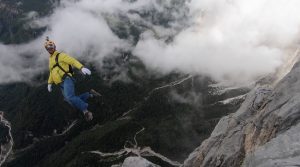
Per quanto riguarda il mestiere di Guida Alpina, immagino sia anche un tuo solido punto fermo per il tuo sostentamento economico e il finanziamento delle altre attività. E’ così o stai anche avendo soddisfazioni con qualche sponsor per le spedizioni che hai fatto ?
Si , diciamo che al momento il solo sostegno economico è il lavoro da guida alpina, ogni tanto faccio qualche show di Highline con la mia ragazza che danza sui tessuti aerei ma niente di più , a parte Monvic che generosamente mi fornisce i vestiti per scalare e PhoenixFly che mi fornisce le tute alari a prezzi molto bassi. Semplicemente nessuno sponsor mi ha cercato e io non ho cercato loro. Se ne hai qualcuno per le scarpe e i vestiti in goratex fammi un fischio, non ho bisogno di molto di più.
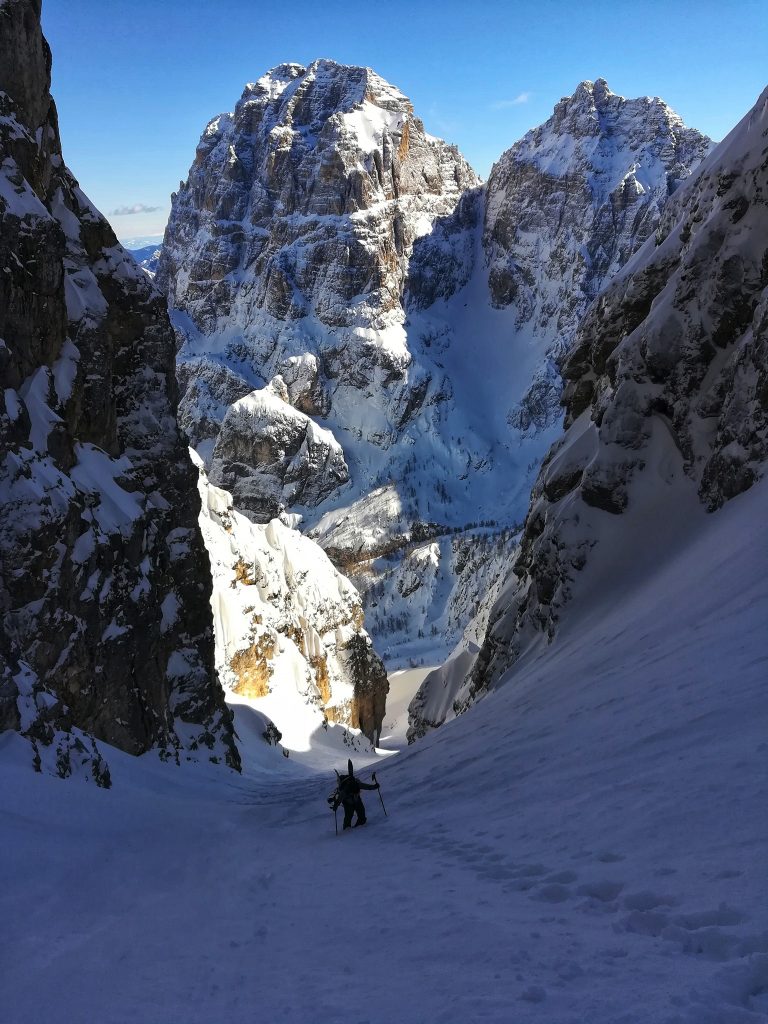
Recentemente hai compiuto un viaggio in Turchia, su Facebook hai postato immagini molto belle di un Paese in grande crescita, per quanto riguarda la presenza di bellissime montagne e siti adatti al volo alare o al Base. Ci riassumi in breve esperienze e numeri, quanti km di avvicinamento, quanti lanci, in quanti giorni ? Per farsi un’idea di quanto possa essere intensa un’esperienza del genere.
Questa esperienza è stata un vero viaggio di esplorazione nelle montagne del lontano nord est della Turchia. Grazie a un jumper locale il governo della regione ci ha appoggiati con tutti i mezzi possibili, pickup , bulldozer per pulire le strade, ambulanze agli atterraggi, barche per il salvataggio in acqua. La prima settimana siamo stati a Uzundere dove praticamente andavamo in giro, guardavamo una montagna trovavamo un modo per salirla( generalmente molto facile perché hanno costruito strade sterrate ovunque per i piloni dell’elettricità) e la saltavamo con o senza tuta alare. Io personalmente nel giorno del mio compleanni ho aperto due exit nuovi. Poi abbiamo saltato castelli diroccati, antenne e pareti più basse. Tutto quello che vedevamo salvabile lo saltavamo, che esperienza!
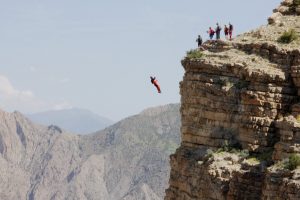
La seconda settimana invece eravamo nel parco di Kamalye, già conosciuto per la scalata (poca), bici, e il base, qui le persone conoscevano l’inglese e non erano cosi conservatori come nel primo villaggio che abbiamo visitato. 15 jumpers sballati sono stati accolti a braccia aperte con il saluto delle autorità e l’inizio dei salti con la tuta alare sopra il paese. Successivamente abbiamo saltato da un cavo teso sopra l’eufrate con una piccola seggiovia creata per l’occasione. Ci mandavano in centro con questo seggiolino e poi saltavamo! wooooow.
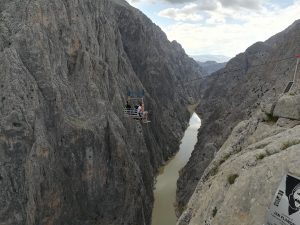
Numeri non saprei, facevamo almeno 3 salti al giorni di media. Km tantissimi anche perché le due località distavano 600 km l’una dall’altra. Tanto kebab a sopratutto era pieno di turchi! (ride,ndr)
Il dibattito sulla estrema pericolosità della tuta alare usata nel BASE, ancor più in contesti alpini, è piuttosto vivace, lo hai sperimentato personalmente in un articolo sulle motivazioni di qualche tempo fa, con commenti sui social che mostrano un brutale cinismo per chi pratica una disciplina così estrema (e aggiungo io, spesso dettati da ignoranza nel senso più stretto della parola). Te lo chiedo brutalmente: cerchi linee di proximity sempre più difficili, exit più complesse, lancio dopo lancio ? O ti imponi una sorta di controllo sui tuoi limiti ? Come prepari un lancio da una exit nuova, da solo o con i compagni cambiano le cose ?
É uno sport nuovo che deve ancora conoscere i suoi limiti, le persone parlano perché non conoscono bene quello di cui si parla, come sempre. Quante volte anche noi “alpinisti” o “ arrampicatori” abbiamo sentito dire che siamo degli incoscienti.
La verità è che c’è un mondo dietro che pochi conoscono, e spesso viene travisato da giornalisti criminali o da pazzi suicidi che voglio buttarsi a tutti i costi perché fa figo. Ma nessuno parla di gente di 60 anni che ha fatto la storia di questo sport con una quantità di salti impressionante ( si parla di 3-4000 salti solo di basejump).
Comunque tornando a noi, in generale cerco sempre un buon motivo per saltare, questo può essere un exit difficile o una linea di proximity estetica ma può anche essere fare salti con amici e seguirsi a vicenda, oppure fare capriole solo per il gusto di vedere il tuo amico farle a fianco a te. Ultimamente cerco invece di trovare una bella montagna da scalare e saltare, non serve abbia un salto difficile.
Un lancio nuovo lo preparo molto attentamente, abbiamo molti dati a disposizione sia sui nostri voli grazie a speciali gps e programmi di voli sia con laser per misurare i nuovi exit e sapere se sono saltabili, studio e ristudio i dati fino a quando sono sicuro che sia fattibile con un adeguato margine di sicurezza, aspetto le condizione atmosferiche e di termiche buone e poi via!
Come hai preparato il trittico sulle Cime di Lavaredo ? Ho letto su planetmountain che hai sentito Thomas Huber, che nel 2008 disegnò una prima idea di concatenazione con base jump..da quanto avevi in mente questo progetto?
Questo progetto è nato alcuni anni fa quando per la prima volta saltai la cima grande. Il concatenamento è stata un idea naturale che mi è saltata in mente. Ho dovuto solo aspettare il momento giusto, quando cioè avevo alle spalle già un po di allenamento con questo stile. L’anno scorso per esempio ho scalato il socondo spigolo in Tofana e in cima ho saltato con la tuta, in totale da macchina a macchina ho impiegato 2 ore e 15 minuti se non sbaglio, li ho capito che avrei potuto provarci anche sulle tre cime.
Si ho sentito Huber per chiedergli del salto dalla ovest di Lavaredo ma poi ho deciso di cambiare programma ed è finita che ho aperto un nuovo exit sulla ovest.
La logistica di questo bel trip non è stata facile perchè avendo due soli paracaduti ho dovuto ripiegarne uno, inoltre uno dei problemi principali era che dovevo trovare il punto da dove saltare sulla piccola e sulla ovest.
Arrivato alla partenza del sentiero per la cima piccola di Lavaredo ho lasciato un paracadute e sono salito con l’altro, ho scalato la normale che è una via di IV, ho fatto una calata e trovato l’exit ho saltato. Ho ripiegato il paracadute nei pressi della chiesetta e mi sono diretto sulle due nord, lasciato un paracadute alla base dello spigolo Dibona mi sono diretto sullo spigolo Demuth, scalato questo fino a metà ho trovato un exit perfetto e ho saltato, non è possibile saltare da nessuna parte più in alto degli strapiombi gialli perchè poi li la parete si appoggia. Infine sono tornato sullo spigolo Dibona e con la tuta e l’altro paracadute ho salito lo spigolo, tra l’altro visto che stava arrivando una brutta nuvola ho corso come un matto salendolo in meno di un ora. In cima ho indossato la tuta e via verso l’ultimo salto con atterraggio su morbida erba.
Un esperinza quasi mistica ma vissuta abbastnaza serenamente, rivedendo i video ho scoperto che ho canticchiato spesso scalando 🙂
Ringraziandoti molto per la tua disponibilità, la domanda finale è : dove stai andando ? Non mi interessa tanto sapere il futuro progetto prossimo, ma capire da te se hai individuato un percorso o qualche obiettivo di medio o lungo termine.
L’obiettivo ultimo è sempre come si dice in inglese “having a good time” ma sicuramente il climb and fly avrà un luogo centrale, lo ritengo la forma più pura per salire una montagna. Slegato con un paracadute in schiena, senza usare chiodi soste e corde, veloce sia nella salita che nella discesa. Non serve lasciare tracce sulla montagna, come a dire “io sono passato di qui” piantando un chiodo. Si lascia tutto intatto. Puro.
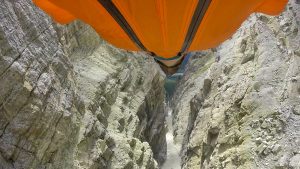
[:en]
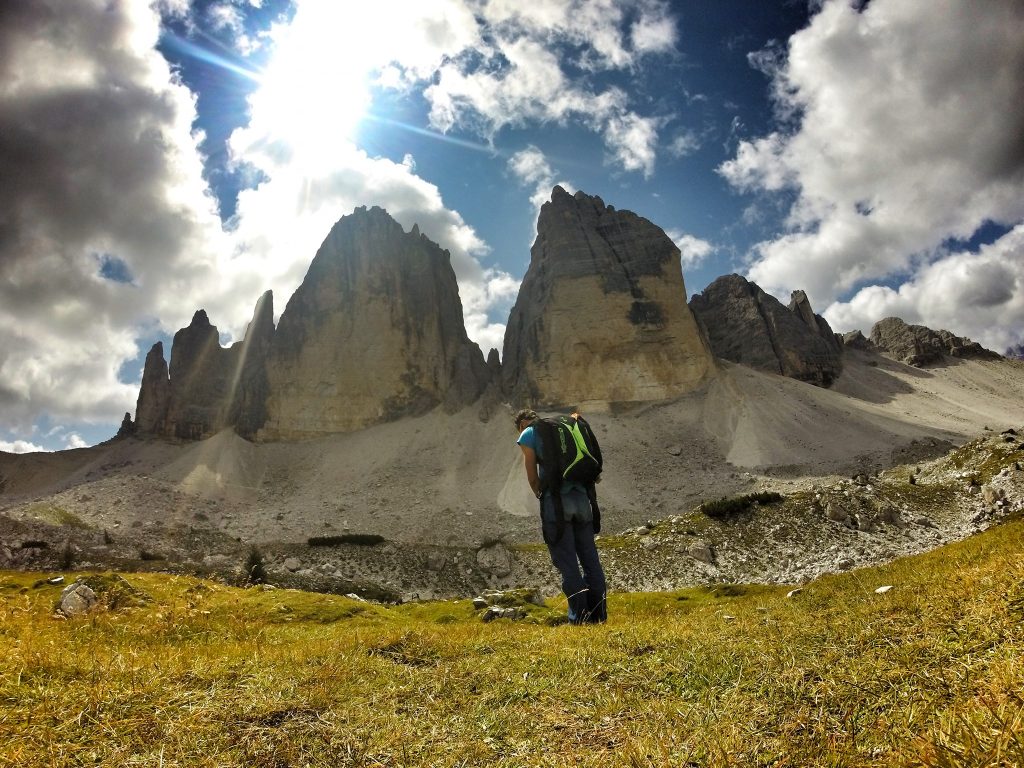
Marco Milanese, from Friuli, born in 1987, studied at the Liceo Scientifico and at the same time carried out professional experience as a rugby player. He started Forestry Sciences, then the mountain “called” him : he then became an Alpine Mountain Guide since 2011, slackliner from 2013, base jumper, wing pilot and speedflyer since 2014.
Marco is getting noticed, since a couple of years, for his very interesting adventures that have had a good echo on social media: he’s not like a compulsive video poster, but in its adventures it is always present a character of experimentation or exploration in the broadest sense, such as the base jump from the Bell Tower of Val Montanaia, the speedflying of a volcano, a trip to Turkey with many base and wingsuit jumps and highlines ; his most recent feat, realized in late August was the freesolo climb of the Tre Cime di Lavaredo in Dolomites, with descent through base and wingsuit base jump from all three peaks.
The following is an interview that has kindly released us – and hopefully will make you understand more deeply the path, the motivations, the emotions that Marco Milanese puts into play in his intense life between Earth and Heaven, looking for a Equilibrium.
Marco : Your progression, your path in balance between climbing and jumping, is something really impressive. By reading your resumé, I have the idea of a kind of monk, because the extensive and fast training in the individual disciplines you have faced, considering the complexity and hardness in managing each one of them. Is that it? Do you have a common methodical approach on all your projects? And if so, what are your greatest difficulties, the limits that you recognize ?
I come from professional rugby so at the beginning of my activity I moved this type of approach in climbing and mountaineering in general, but lately, also because of the work as a mountain guide, I cannot train so constantly. Fortunately I still have a little ‘margin physically speaking, but lately I’m mainly training the mind, which is something you can not do in a climbing panel, you have to go out, you have to be exposed. I do not have a common approach to projects except for the fact that when they start to turn around in my head they do not leave me alone, I practice too many different activities that require very different approaches. The limits that I recognize are certainly not having a physical-fit body for climbing at high levels, and a mind that does not bear too much long drudgin’ around. I’m more a type of “Fast & furious” but who knows what will happen to me soon or later …
I have a curiosity about your path between disciples : I know that generally at least a 200 jumps from the plane are considered indispensable before the transit to the base jump. More to wear a wingsuit, both in the air then to Alpine Base. But there are exceptions. Can you tell us something about it? What or who inspired you on this road of jumping, which strongly intersect with mountaineering ?
I have always had a strong attraction towards emptiness, it relaxes me, makes me think more clearly. I researched it at the beginning with the climbing.. because it was the most obvious thing, then with the highline and finally, thanks to a left wrist injury that did not allow me to climb, but to open a parachute, I threw myself in this adventure .
The “normal” route to jump from the mountains with a wingsuit is long. You need 200 jumps from the plane before you can wear a small beginner jumpsuit, as you need 200 to do a base jumping course. Then the two things come together, the basejumping and the wingsuit. I say that I have speeded up a few steps – but I want to assure you that I have never skipped any step!
The unaware people in this base world… they are another thing, is just a new type of a suicide (because it is not possible to assimilate it to the world of BASE) ..there was one guy that had 5 jumps from the plane and no experience of mountain ,nor wing suit who decided to try, easy no? He will have seen it many times in the videos. I let you imagine the bitter end. Combining mountaineering and BASE has become something natural for me, but in a right way.
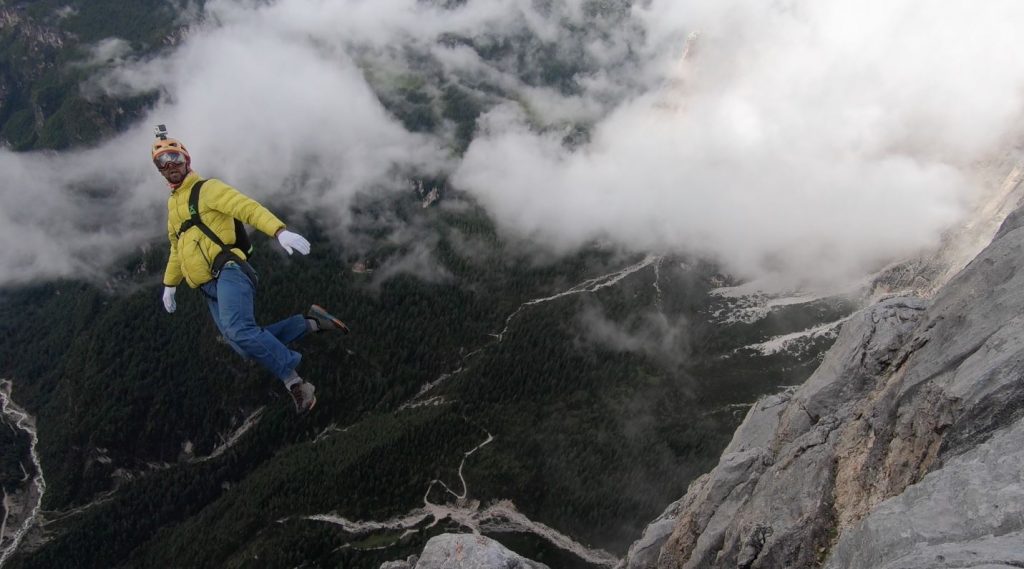
As for your professional job as Alpine Guide, I imagine it is your solid point for your financial support – and main source to have budget for other activities. Is it like that or are you also having satisfactions with some sponsors for the missions, you’ve made?
Yes, let’s say that at the moment the only economic support is the alpine guidejob, sometimes also I do some Highline shows with my girlfriend- she’s dancing on the aerial fabrics but nothing more, apart from Monvic who generously provides me with the clothes to climb and PhoenixFly who supplies me with wing suits at very low prices. As for now, nobody sponsored me and I did not look for them. If you have someone for shoes and clothes in goratex let me know, I do not need much more.
Recently you have made a trip to Turkey, on Facebook you have posted very beautiful images showing a country in great growth, talking about the presence of beautiful mountains and sites suitable for flights, base , climbing, highlining. Can you summarize brifly your experiences and numbers, how long were the approach, how many jumps, how many days? To get an idea of how intense was that whole experience.
This experience was a real exploration trip in the mountains of the far north-east of Turkey. Thanks to a local jumper. the government of the region has supported us with all possible means, pickups, bulldozers to clean the streets, ambulances to landings, boats for water rescue. The first week we were in Uzundere where we practically went around, we looked at a mountain we found a way to climb it (generally very easy because they built dirt roads everywhere to build electricity pylons) and jumped with or without wingsuit. I personally opened two new exits on the day of my birthday. Then we jumped ruined castles, antennas and lower walls. Everything we saw as safe we jumped it, what an experience!

The second week we were in the park of Kamalye, already known for the climb (little), bike, and the base, here people knew English and were not as conservative as in the first village we visited. 15 busted jumpers were welcomed with open arms with the greetings of the authorities and the beginning of the jumps with the wingsuit over the village. Later we jumped from a stretched cable above the euphrates with a small chairlift created for the occasion. They sent us downtown with this seat and then jumped! wooooow.
Numbers I do not know, we did at least 3 jumps on average days. Many kilometers, also because the two localities were 600 km from each other. So much kebab was especially full of Turks! (laughs)…
The debate about the extreme danger of the wingsuit used in BASE, even more in Alpine contexts, is quite lively, you have personally experienced in an article on the motivations of some time ago, with comments on social media showing a brutal cynicism for those who practice a discipline so extreme (and I add, often dictated by ignorance in the narrowest sense of the word). I ask you brutally: do you look for increasingly difficult proximity lines, more complex exits, launch after launch? Or do you impose a kind of control over your limits? How do you prepare a launch from a new exit, alone or with the companions change things?
It is a new sport that has yet to know its limits, people speak because they do not know well what they are talking about, as always. How often we “alpinists” or “climbers” have heard that we are unconscious.
The truth is that there is a world behind that few know, and often is misrepresented by criminal journalists or suicide madmen who want to throw at all costs because it is cool. But nobody talks about 60-year-olds who have made the history of this sport with an impressive amount of jumps (we are talking about 3-4000 jumps only of basejump).
However returning to us, in general I always look for a good reason to jump, this can be a difficult exit or a line of aesthetic proximity but can also be jumps with friends and follow each other, or do somersaults just for the sake of seeing the your friend make them next to you. Lately I try instead to find a beautiful mountain to climb and jump, no need to have a difficult jump.
A new exit…I prepare it very carefully, we have a lot of data available on our flights thanks to special gps and flight schedules and with lasers to measure the new exits and know if they are feasible, I study and review the data until I am sure that be feasible with an adequate safety margin, look good atmospheric conditions and good thermals and then go!
How did you prepare the triptych on the Cime di Lavaredo? I read on planetmountain that you heard Thomas Huber, who in 2008 drew a first idea of concatenation with a base jump..da what did you have in mind this project?
This project was born a few years ago when for the first time I jumped the big top. The chaining was a natural idea that jumped into my mind. I just had to wait for the right time, when I had already a bit of training with this style behind me. Last year for example I climbed the socondo edge in Tofana and at the top I jumped with the suit, in total from machine to car I took 2 hours and 15 minutes if I’m not mistaken, I realized that I could also try on the three peaks .
I spoke with Huber asking him about the jump from the west of Lavaredo but then I decided to change the program and it’s over that I opened a new exit on the west.
The logistics of this nice trip was not easy because having only two parachutes I had to fold one, also one of the main problems was that I had to find the point from where to jump on the small and west.
Arrived at the start of the path to the small top of Lavaredo I left a parachute and I climbed with the other, I climbed the normal which is a way of IV, I dropped and found the exit I jumped. I folded the parachute near the church and I headed on the two north, left a parachute at the base of the edge Dibona I headed to the edge Demuth, climbed this halfway I found a perfect exit and I jumped, you can not jump from no part higher than the yellow cliffs because then the wall is supported. Finally I went back to the Dibona corner and with the suit and the other parachute I climbed the corner, among other things, as a bad cloud was coming I ran like crazy going up in less than an hour. At the top I wore the suit and off to the last jump with landing on soft grass.
An almost mystical experience but lived smoothly, reviewing the videos I discovered that I often sang songs while climbing 🙂
Thanking you for your time, the final question is: where are you going? I do not care much about knowing the next project, but understanding from you if you have identified a path or some medium /long term goal.
The ultimate goal is always as they say in English “having a good time” but certainly the climb and fly will have a central place, I think it is the purest form to climb a mountain. Attached with a parachute in the back, without using stopping nails and ropes, fast both in the ascent and in the descent. You do not need to leave traces on the mountain, as if to say “I have passed by here” by planting a nail. It leaves everything intact. Pure.

[:]